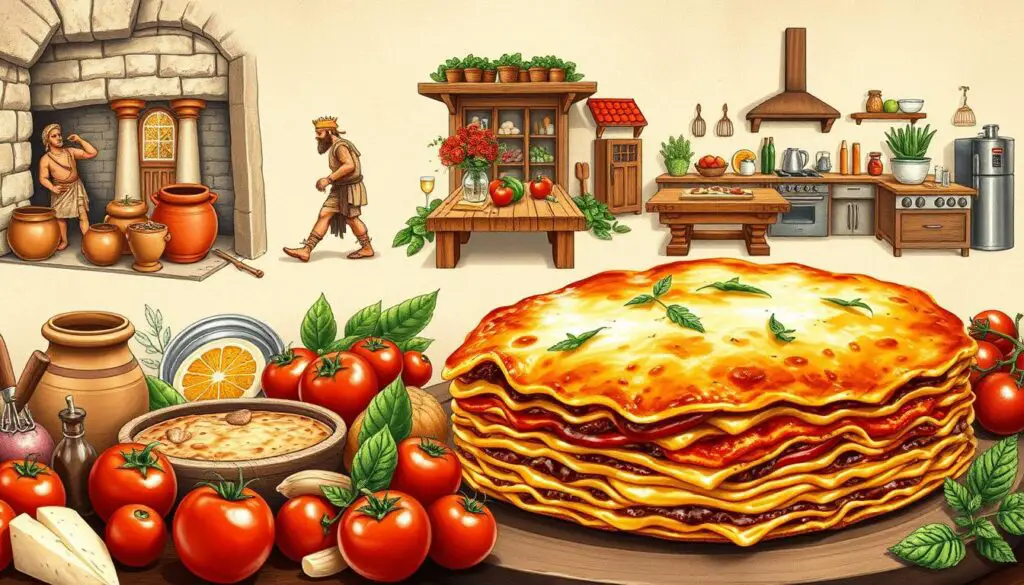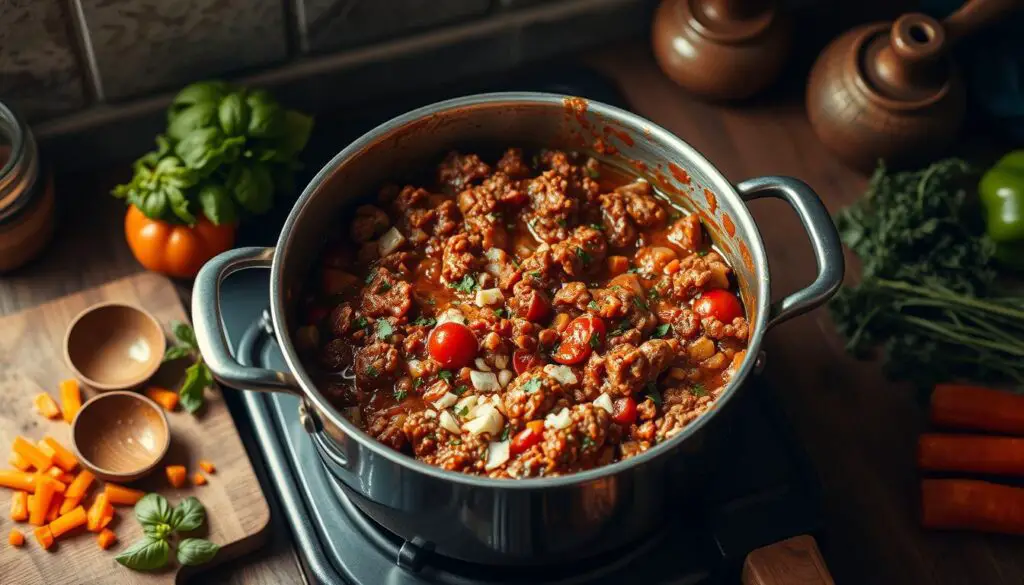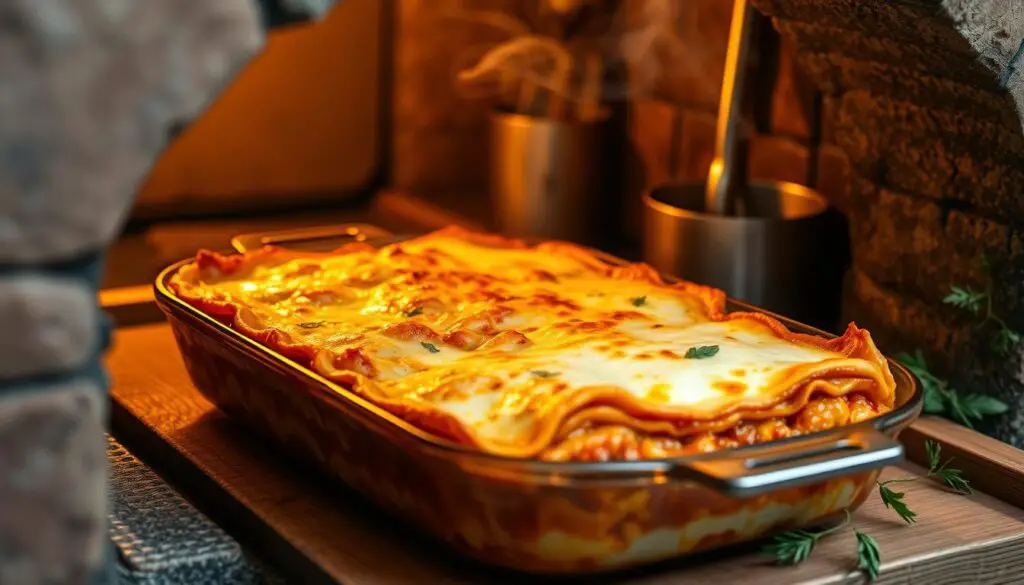Lasagne is more than just a meal; it’s a comforting dish that holds a special place in many American homes. This classic lasagne recipe brings together layers of rich meat sauce, creamy cheese, and perfectly cooked pasta, making it an ideal choice for family dinner gatherings. The experience of sharing a slice of this savory dish creates lasting memories and emphasizes the cultural significance of lasagne as a beloved comfort food across the nation. As we dive deep into the steps of preparing this delightful meal, let’s celebrate the essence of American cuisine that makes lasagne a staple at the dinner table.
Key Takeaways
- Lasagne is a classic American comfort food perfect for family dinners.
- Rich layers of meat sauce, cheese, and pasta create unforgettable flavors.
- Sharing a lasagne dish fosters family bonding and tradition.
- Preparing lasagne can be a rewarding cooking experience.
- This dish has a significant cultural impact on American cuisine.
Introduction to Lasagne
Lasagne has a rich and fascinating background that showcases its journey through time and cultures. This beloved dish, with layers of pasta and savory fillings, traces its origins back to ancient civilizations. It has evolved significantly, particularly within Italian cuisine, where various regions have adopted unique twists, contributing to its depth and versatility.
The History of Lasagne
The history of lasagne reveals its roots in Greco-Roman traditions, where layered dishes were crafted using flat sheets of pasta. Over the centuries, this concept transformed in Italy, leading to the beloved lasagne we enjoy today. From the rich flavors of Bolognese sauce in Emilia-Romagna to the lighter versions found in Southern Italy, regional diversity enriches the dish. As Italian immigrants settled in the United States, lasagne gained enormous popularity and became a hallmark of family gatherings, loved for its heartiness and satisfying nature.
Why It’s a Family Favorite
Lasagne’s appeal as a family favorite stems from more than just its delicious taste. The richness of flavors and the comforting textures make it a quintessential family meal. Preparing lasagne often turns into a collaborative event, with family members joining together to layer ingredients and create a delightful dish. Its ability to feed a crowd and cater to various tastes adds to its reputation, making it a timeless recipe across generations.

Ingredients Needed
Preparing a delicious lasagne starts with the right selection of ingredients. The essence of a satisfying dish lies in the quality and combination of the lasagne ingredients. In a classic recipe, you’ll find essential components that come together to create comfort food at its best.
Key Components of a Classic Lasagne
Every lasagne recipe should include the following classic lasagne components:
- Lasagne noodles
- Ricotta cheese
- Mozzarella cheese
- Marinara sauce
- Ground meat (beef, pork, or turkey)
These core ingredients provide a balanced foundation for this timeless dish. Opting for high-quality cheeses and fresh noodles enhances the overall flavor profile significantly.
Optional Ingredients for Extra Flavor
To elevate your lasagne, consider adding various flavor enhancements that can bring more depth to the dish. These optional ingredients include:
- Sautéed vegetables (spinach, zucchini, or bell peppers)
- Different types of cheese (Parmesan, provolone, or goat cheese)
- Herbs and spices (basil, oregano, or garlic)
- A dash of red wine or cream for sauce

Incorporating these optional ingredients allows for personal touches and diverse flavor profiles, making each preparation unique and exciting.
| Category | Ingredients |
|---|---|
| Classic Components | Lasagne noodles, Ricotta cheese, Mozzarella cheese, Marinara sauce, Ground meat |
| Flavor Enhancements | Sautéed vegetables, Different cheeses, Herbs and spices, Red wine or cream |
Preparing the Meat Sauce
Creating a rich meat sauce is essential for a memorable lasagne. The right choice of meat and the proper cooking techniques can elevate the flavors in your dish significantly. Understanding which meats work best and how to cook them will greatly enhance your meat sauce preparation.
Choosing the Right Meat
Some of the best meat for lasagne includes ground beef, pork, and turkey. Ground beef tends to provide a robust flavor that complements the layers of cheese and pasta beautifully. Pork adds a hint of sweetness and moisture, making it an excellent choice for a richer sauce. Ground turkey is a leaner option that provides a lighter flavor, appealing to those seeking lower-fat alternatives.
Cooking Techniques for Flavor
Effective meat sauce preparation starts with browning the meat. This process caramelizes the meat’s natural sugars, creating a depth of flavor that forms the base of your sauce. Incorporating aromatic vegetables, such as onions and garlic, further enhances the flavor profile. Simmering the sauce for an extended period allows the ingredients to meld together, resulting in a harmonious blend of taste and aroma.
Consider the following flavor techniques to maximize your sauce:
- Season the meat with salt and pepper before browning to enhance flavor.
- Add fresh herbs like basil and oregano during cooking for added depth.
- Include a splash of red wine for acidity and complexity.
Combining these elements results in a savory and hearty meat sauce that serves as the perfect foundation for your beloved lasagne.

| Type of Meat | Flavor Profile | Best Uses |
|---|---|---|
| Ground Beef | Robust, savory | Classic lasagne, meatballs |
| Pork | Sweet, moist | Rich sauces, meat ragu |
| Ground Turkey | Light, mild | Health-conscious dishes, lighter lasagne |
Making the Cheese Mixture
The cheese mixture for lasagne is what gives this dish its signature creamy texture and rich flavor. Selecting the right cheese types plays a crucial role in achieving a harmonious blend that elevates your lasagne. Commonly, a ricotta cheese blend becomes the base, enhanced with other ingredients to create an irresistible filling.
Types of Cheese to Use
Creating the perfect cheese mixture for lasagne typically involves a combination of several cheese types. Here are some of the best options:
- Ricotta: This soft cheese forms the heart of the mixture, providing creaminess.
- Mozzarella: Adds melty goodness and stretchiness, complementing the ricotta.
- Parmesan: Offers a sharp flavor profile that enhances the overall taste.
- Fontina: Delivers a rich and nutty flavor, perfect for extra depth.
Making a Creamy Ricotta Blend
To create a luscious ricotta cheese blend, follow these simple steps:
- Begin with fresh ricotta cheese. Aim for high-quality and creamy texture for the best results.
- In a mixing bowl, combine ricotta with an egg. This adds richness and helps bind the mixture.
- Stir in grated Parmesan cheese for depth and flavor.
- Season the blend with salt, pepper, and fresh herbs like basil or parsley for added freshness.
Mix thoroughly until you achieve a smooth and creamy consistency. This ricotta cheese blend becomes the foundation that layers perfectly between the pasta sheets, creating an unforgettable lasagne.

Pasta: Fresh vs. Dried
When preparing lasagne, one key decision revolves around the type of pasta used. Fresh pasta and dried pasta each bring unique characteristics to the dish. Understanding the fresh pasta advantages can make a significant difference in the final outcome of your lasagne.
Benefits of Fresh Pasta
Fresh pasta is known for its soft texture and ability to absorb flavors from sauces. It pairs beautifully with hearty fillings and adds a homemade touch to your lasagne. Some advantages include:
- Texture: Fresh pasta provides a delicate and chewy texture that enhances your eating experience.
- Flavor: Its subtle flavor complements rich sauces and fillings, making each bite enjoyable.
- Quick Cooking Time: Fresh pasta typically cooks faster than dried varieties, reducing preparation time.
- Versatility: Homemade fresh pasta allows you to experiment with different flours and flavors.
How to Cook Dried Pasta Perfectly
Many home cooks prefer the convenience of dried lasagne noodles. Proper cooking is essential to achieve the desired texture. Here are some tips for cooking dried pasta effectively:
- Choose a large pot and fill it with water. Use a generous amount of water to prevent sticking.
- Add a pinch of salt to the boiling water. Salting enhances flavor.
- Follow the package instructions for cooking time, keeping an eye on the noodles to avoid overcooking.
- Test the pasta by tasting it; it should be al dente, offering a slight resistance when bitten.
- Drain the noodles, but reserve a bit of pasta water. This can be helpful in adjusting the sauce consistency if needed.
Layering Your Lasagne
The key to a delectable lasagne lies in the methodical process of layering. Properly executed layering not only enhances flavor but also ensures that each bite provides a balanced experience. Mastering lasagne assembly techniques opens up new possibilities for creating a hearty dish with rich flavors. Below are some essential strategies for effective ingredient distribution throughout your lasagne.
Ideal Layering Techniques
When layering lasagne, consider the following techniques for optimal results:
- Start with a thin layer of sauce at the bottom of your baking dish to create a non-stick base.
- Place noodles directly on top of the sauce. Overlap them slightly to ensure complete coverage.
- Next, add a layer of meat sauce followed by a generous layer of cheese. Repeat these layers, ensuring that the final layer remains cheese-heavy for a pleasing crust.
- Stay mindful of texture. Alternate between sauces and cheeses to establish a delightful balance
Tips for Even Distribution of Ingredients
Achieving even ingredient distribution is vital for both flavor and visual appeal. Follow these suggestions:
- Use a ladle to spread sauce evenly, ensuring no dry noodle areas are left.
- Gently press down each layer to compact the fillings and assist in preventing overflow during baking.
- Avoid overloading individual layers, which can compromise structural integrity and lead to a messy slice.
- Incorporate fresh herbs like basil or oregano between layers for added dimension and flavor.

By adhering to these layering lasagne techniques, the assembly process transforms into an art form, promoting delightful ingredient distribution that complements the entire dish. Enjoy the satisfaction of a well-crafted lasagne that dazzles both the eyes and the palate.
Baking the Lasagne
The final step in creating the perfect lasagne involves paying close attention to the baking temperature lasagne. Getting this right determines whether the dish is perfectly cooked, achieving a delightful balance between a juicy interior and a crisp exterior. Follow these essential lasagne cooking tips to master the baking process.
The Perfect Oven Temperature
For optimal results, preheat your oven to 375°F (190°C). This baking temperature lasagne allows each layer to cook thoroughly without the risk of burning. It is advisable to cover the lasagne with aluminum foil for the first 30-40 minutes. This step helps retain moisture, ensuring the noodles cook properly.
How to Achieve a Golden Top
To create that desirable golden crust, remove the foil for the last 15-20 minutes of baking. This action allows the top layer of cheese to melt beautifully, forming a bubbly, golden finish. Keep an eye on the lasagne as it bakes; every oven behaves differently. A quick check for doneness can be done by inserting a knife in the center; it should go in easily when the dish is fully cooked.

| Baking Step | Action | Time |
|---|---|---|
| Preheat Oven | Set to 375°F (190°C) | N/A |
| Cover Lasagne | Wrap with foil | 30-40 minutes |
| Uncover Lasagne | Remove foil | 15-20 minutes |
| Check Doneness | Insert knife in center | N/A |
Serving Suggestions
Serving lasagne can elevate your meal experience, making it both memorable and delicious. With thoughtful presentation and the right meal accompaniments, your dish will steal the show at any gathering. This section explores ideal pairings and presentation tips to enhance your lasagne experience.
Accompaniments That Pair Well
Here are some excellent meal accompaniments to consider when serving lasagne:
- Garlic Bread: A classic side that complements the richness of lasagne, providing a delightful crunch.
- Green Salad: A fresh salad with vinaigrette can balance out the hearty meal, adding brightness to your plate.
- Steamed Vegetables: Seasonal vegetables such as broccoli or asparagus enhance the nutrition and color of your meal.
- Wine Pairings: Red wines, such as Chianti or Merlot, pair perfectly with lasagne, enhancing the flavors.
How to Present Your Lasagne
Presentation tips can transform your meal into a feast for the eyes. Consider the following techniques:
- Proper Slicing: Use a sharp knife to ensure clean, even slices. This creates a beautiful serving.
- Garnishing: Fresh basil or parsley can add a pop of color and freshness on top of your lasagne.
- Plate Selection: Choose wide, shallow plates to highlight your lasagne’s layers and color.
- Serve Hot: Ensure your lasagne is heated through and bubbly, presenting it fresh from the oven.
Variations on Our Favourite Lasagne Recipe
Lasagne is a versatile dish that can accommodate various dietary needs without sacrificing flavor. By exploring different variations, you can create delightful meals that cater to everyone at the table. This section dives into exciting vegetarian lasagne options and offers gluten-free alternatives, ensuring that everyone can enjoy this beloved classic.
Vegetarian Lasagne Options
For those who prefer a meatless meal, vegetarian lasagne is a fantastic choice. Utilizing fresh, seasonal vegetables like spinach, mushrooms, and bell peppers, this option can be both nutritious and satisfying. Incorporating plant-based proteins such as lentils or chickpeas adds heartiness to the dish. Here are some popular ingredients to consider:
- Spinach and ricotta for a creamy filling
- Mushroom and garlic for savory flavors
- Roasted zucchini or eggplant as layers
Gluten-Free Lasagne Alternatives
For those seeking gluten-free options, there are delicious alternatives that preserve the essence of traditional lasagne. Using gluten-free noodles or opting for vegetable slices like zucchini can create a satisfying base. These alternatives maintain the rich layers while accommodating dietary restrictions. Here are some suggestions for gluten-free lasagne:
- Gluten-free whole grain lasagne noodles
- Thinly sliced zucchini or sweet potatoes to replace pasta
- Cauliflower based sauces to enhance flavor
Storage Tips for Leftovers
Proper storage techniques are essential for maintaining the flavor and freshness of lasagne leftovers. Effective food preservation methods can significantly extend the life of your meal. Storing lasagne leftovers with care ensures that you can enjoy them later without compromising quality.
How to Properly Store Lasagne
To ensure your lasagne stays fresh, consider using the following methods:
- Cover the dish tightly with aluminum foil or plastic wrap to keep moisture in.
- Transfer the leftovers to an airtight container. This minimizes air exposure and prevents spoilage.
- Label the container with the date to keep track of how long it has been stored.
Reheating Tips for Best Quality
Reheating lasagne without sacrificing texture can be achieved effectively by using these methods:
- Preheat your oven to 350°F (175°C) and bake the lasagne for about 25-30 minutes, covered with foil to retain moisture.
- If you’re short on time, use a microwave. Heat individual portions for 1-2 minutes, checking for even warming to avoid cold spots.
- Let the lasagne stand for a few minutes after reheating; this helps the layers settle for better texture.
Healthier Alternatives
Creating a delicious lasagne doesn’t have to come at the cost of nutrition. By exploring healthier lasagne options, cooks can enjoy this beloved dish while maintaining better dietary habits. Simple ingredient substitutions make a significant difference in calories without sacrificing flavor.
Substituting Ingredients for Healthier Options
One effective way to transform a traditional lasagne into a healthier recipe involves substituting high-calorie ingredients. Consider these swaps:
- Use low-fat cheese instead of regular cheese to cut down on fat and calories.
- Replace traditional lasagne noodles with whole wheat or zucchini slices for added fiber.
- Incorporate additional vegetables, such as spinach or mushrooms, to increase nutrients.
Making a Low-Calorie Lasagne
To create a low-calorie recipe, focus on both the quantity and quality of ingredients. Here’s a straightforward method to prepare a satisfying yet lighter lasagne:
- Begin with a base of whole wheat noodles or sliced vegetables.
- Prepare a lean meat sauce using ground turkey or chicken and plenty of chopped vegetables.
- Mix low-fat ricotta cheese with spinach for a nutritious filling.
- Layer everything and top with a sprinkle of part-skim mozzarella cheese.
- Bake until bubbling and golden, achieving a healthy and satisfying meal.
These ingredient substitutions and techniques provide a wonderful way to enjoy lasagne without the guilt, allowing families to indulge in a classic dish that aligns with healthier eating goals.
| Ingredient | Standard Version | Healthier Alternative | Calorie Difference |
|---|---|---|---|
| Cheese | Full-Fat Mozzarella | Low-Fat Mozzarella | -60 calories per serving |
| Pasta | Regular Lasagne Noodles | Whole Wheat Lasagne Noodles | -50 calories per serving |
| Meat | Ground Beef | Ground Turkey | -90 calories per serving |
| Sauce | Creamy Alfredo | Tomato-Based Sauce | -100 calories per serving |
Our favourite lasagne recipe
Creating the perfect lasagne can be a rewarding culinary journey, especially when you have a comprehensive lasagne recipe guide at your fingertips. This section offers a detailed step-by-step lasagne to ensure you achieve a mouthwatering result every time. Along with the recipe, we will shine a light on common mistakes to avoid for a flawless dish.
Step-by-Step Guide to Our Recipe
- Preheat your oven to 375°F (190°C).
- Prepare your meat sauce. Cook your chosen meat in a skillet until browned. Add diced onions, garlic, and tomatoes, simmering to merge the flavors.
- Craft the cheese mixture. In a bowl, combine ricotta cheese, egg, parsley, and parmesan cheese.
- Cook lasagne noodles according to package instructions until al dente, ensuring they don’t become mushy.
- Start layering. In a baking dish, spread a layer of meat sauce, then noodles, followed by the cheese mixture. Repeat layers until all ingredients are used, ending with noodles topped with meat sauce.
- Cover the top layer with mozzarella cheese and bake for 40-45 minutes until golden and bubbling.
- Let the lasagne rest for at least 15 minutes before slicing to enhance flavor and ease of serving.
Common Mistakes to Avoid
- Not using enough seasoning in your meat sauce, which can lead to a bland flavor.
- Overcooking the noodles, as they will absorb moisture from sauces while baking.
- Skipping the resting period. Letting the lasagne settle allows the layers to bind, making it easier to serve.
- Using cold ingredients straight from the fridge. Room temperature ingredients blend better and cook evenly.
- Forgetting to cover the dish with foil in the initial baking stages can lead to a dry top layer.
Utilizing this detailed approach will aid in mastering your lasagne, making your gatherings even more special with this classic dish.
Conclusion
In summary, the journey through our favorite lasagne recipe highlights the heartwarming tradition of bringing families together around the dinner table. From the rich meat sauce to the creamy cheese layers, each element contributes not just to a meal but to shared memories and joyful experiences. Lasagne is undeniably a staple for a family meal, cherished for its delicious flavors and hearty portions.
As we’ve explored, this beloved dish is incredibly versatile, allowing cooks to put their unique spin on it with various ingredients and techniques. Whether you choose to stick closely to the classic recipe or venture into exciting variations such as vegetarian or gluten-free options, the important part is to enjoy the process and the satisfaction that comes with serving a homemade lasagne.
Ultimately, lasagne is more than just a recipe; it’s an opportunity to create connections and enjoy quality time with loved ones. So gather your ingredients, embrace your creativity, and indulge in the comforting allure of this classic dish.
FAQ
What is a classic lasagne recipe?
A classic lasagne recipe typically involves layers of rich meat sauce, creamy cheese mixture, and lasagne noodles, baked to perfection for a comforting family dinner. The key ingredients include ricotta cheese, mozzarella, marinara sauce, and ground meat.
How long should I cook lasagne?
Baking lasagne generally takes about 45 minutes to 1 hour at an oven temperature of 375°F. It’s essential to ensure that the cheese is bubbly and the top is golden brown for the best result.
Can I make lasagne ahead of time?
Yes, you can assemble the lasagne in advance and store it in the refrigerator for up to 24 hours before baking. Alternatively, you can freeze unbaked lasagne for up to three months and bake it directly from frozen.
What are some vegetarian alternatives for lasagne?
Vegetarian lasagne options often replace meat with layers of seasonal vegetables, mushrooms, or plant-based proteins. Ingredients such as spinach, zucchini, or butternut squash can add flavor and texture.
How do I achieve a creamy cheese mixture?
To create a creamy cheese mixture for lasagne, blend ricotta cheese with mozzarella, Parmesan, and eggs. Adding herbs like parsley or basil can enhance the flavor.
What can I serve with lasagne?
Lasagne pairs well with garlic bread, mixed green salads, or a glass of red wine. These accompaniments complement the rich flavors of the dish and enhance the dining experience.
How do I store leftover lasagne?
Store leftover lasagne in an airtight container in the refrigerator for up to 3-5 days. For longer storage, consider freezing portions, which can last up to 3 months without losing flavor.
What are common mistakes to avoid when making lasagne?
Common mistakes include overcooking the noodles, using watery sauces, or skipping the resting time after baking. Allowing lasagne to sit for at least 15 minutes before slicing helps it set and makes serving easier.

Your article helped me a lot, is there any more related content? Thanks!
Thank you for your sharing. I am worried that I lack creative ideas. It is your article that makes me full of hope. Thank you. But, I have a question, can you help me?
Thank you for your sharing. I am worried that I lack creative ideas. It is your article that makes me full of hope. Thank you. But, I have a question, can you help me?